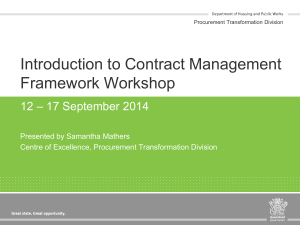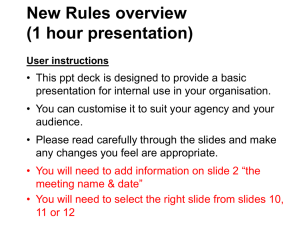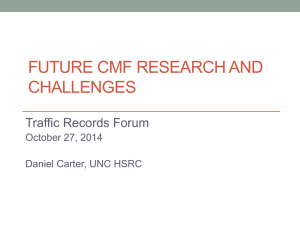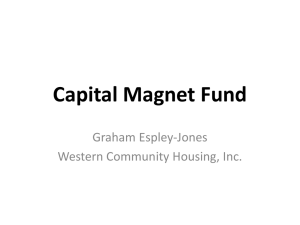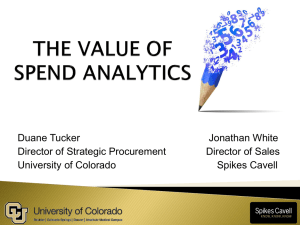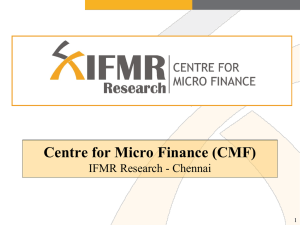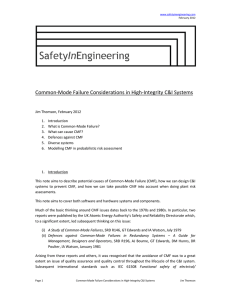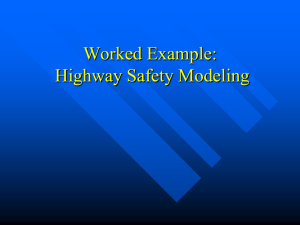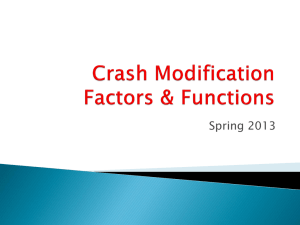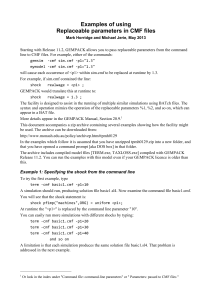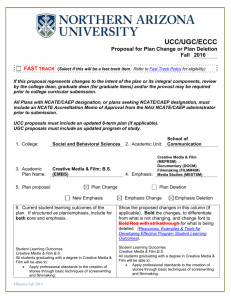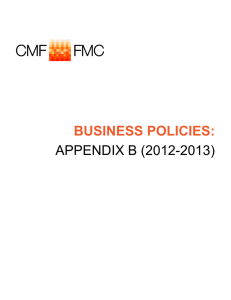Introduction to Contract Management Framework Workshop
advertisement
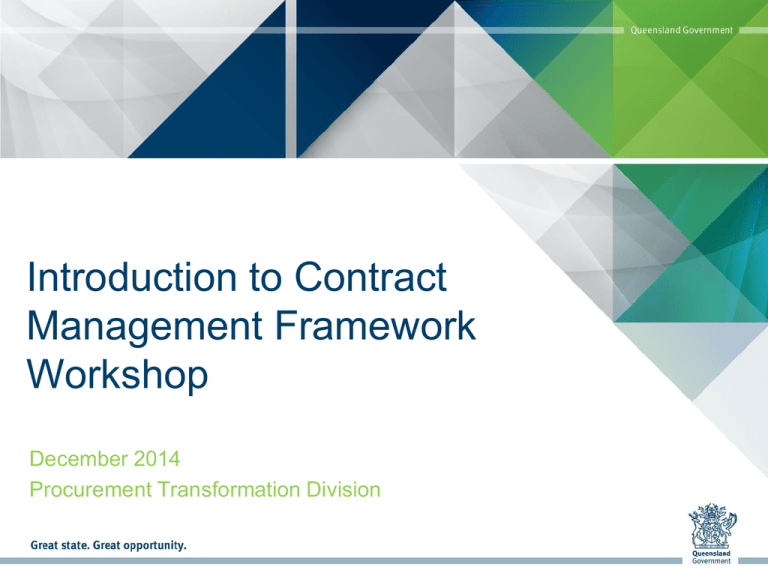
Introduction to Contract Management Framework Workshop December 2014 Procurement Transformation Division < Month 2013 > Workshop Outline 1. Purpose and objectives of this workshop 2. Why is contract management important? 3. QAO Audit Report Recommendations 4. Overview of One Government CMF 5. Supporting tools and templates 6. Effective contract management begins with early planning 7. Roles and responsibilities defined in the CMF 8. Value / risk approach to contract management 9. Contract management plans 10. Contract extensions and renewals 11. Re-cap key messages 12. Operationalising the CMF in Agencies 13. Further training and next steps “A pessimist sees the difficulty in every opportunity. An optimist sees the opportunity in every difficulty” Which do you choose to be? Workshop purpose and objectives Purpose: • to provide you with important information and improve your understanding of the new Contract Management Framework (CMF) and supporting tools • so you can share knowledge and provide similar workshops within your own Agency. Objectives provide attendees with: • an overview of the new CMF and supporting tools/templates and key messages • an understanding of the key drivers behind the establishment of a contract management framework and supporting tools • a better understanding of how some of the most frequently used tools are intended to be used (e.g. value risk matrix, contract management checklist, contract management plan, contract extension and renewal checklist) • a presentation pack, that can be used to conduct training and information sessions within your agency. This is not a substitute for more comprehensive contract management training Why is contract management important? Why is contract management important? Role of contract management in retaining and improving value for money Benefits of contract management: • Obtaining value for money • Managing risk • Maximising end user outcomes Effective contract / supplier management Value for money The effective management of contracts with suppliers is critical to Queensland Government maximising benefits from procurement: VfM achieved through procurement Contract management benefit Poor contract management Procurement Activities Ongoing contract management (and category management activities) Time QAO Audit Report Recommendations 1. Improve capability 2. Value / risk approach Develop and implement a contract management capability framework Apply a value/risk matrix to define expectations for contract management and appropriate resource allocation to contracts On-line procurement induction program to include contract management module Contract management training Value/risk matrix One Government CMF Contract management plan and Contract management checklist templates 3. Contract extensions and renewals 4. Contract management lifecycle system Validate value for money before extending/renewing a contract, through assessment of contract risk, demand, supply market and supplier performance Checklist for contract extensions/renewals Fact Sheet (including FAQ’s) Contract Review Report template One Govt CMF Implement a contract management lifecycle system to enable spend analysis, monitoring of supplier performance, early triggers to prepare for contract expiry Q-Contracts Supporting processes Contract register Q-Contracts One Government Contract Management Framework Contract Management Framework (CMF) Contract Management Framework available on HPW website Contract Management Guidance available on HPW website Background to its development and purpose: • Consistency • Ensure contractual obligations are met, risks are managed, value obtained • Describes the three major phases of the contract management lifecycle and key activities: Phase 1 – Contract set up Phase 2 – Contract management Phase 3 – Contract close out Scope: focus is on contract management once a contract is in place (although planning is key) Supporting materials: • Tools and templates (see next slide) • Fact sheets: Value Risk Matrix, Extending and Renewing Contracts • Procurement guidance – managing and monitoring supplier performance Supporting tools and templates Phase 1 – Contract set up tools and templates Value/risk matrix Classify a contract (as either routine, focused or strategic) based on value and risk. Contract management checklist Suitable for routine contracts – a brief summary of key information relevant to contract management. Contract management plan Define the key activities and responsibilities for managing the contract. A guide for the contract kick-off meeting. Contract kick-off meeting template Phase 2 – Contract management tools and templates Contract performance review meeting template Support the contract manager to conduct and document a contract performance review meeting. Risk register template Checklist for contract extensions/renewals Record and maintain a single repository for contract risks. Record the value for money assessment of a contract extension or renewal (suitable for routine contracts) Contract review report Record the analysis performed and recommendation to extend or renew a contract, or transition to other suppliers. Phase 3 – Contract close-out tools and templates Lessons learned log template Document lessons learned throughout the contract lifecycle. Close-out check list Confirm all close-out activities have been performed. Effective contract management begins with good planning in procurement phase Contract management requires involvement during the Procurement process and not simply after the contract has been awarded. Effective contract management starts at the sourcing process through to the relationship management of the supplier to ensure the optimum efficiency and increased service levels so as to avoid having to utilise contractual terms to achieve the performance expectations. It’s a process that requires teamwork and partnership skills through regular reviews and engagement. Roles and responsibilities defined What is: • a Contract Owner? • a Contract Manager? • a Contract Administrator? Greater collaboration between the procurement sourcing lead and contract manager • Early identification of contract management skills and capability needed • Contract managers contribute subject matter expertise and experience • Sourcing lead in best position to develop contract management plan (in consultation with contract manager – see next slide) Better handover between sourcing lead and contract manager = smoother transition Don’t “throw it over the fence!” Value/risk approach to contract management How to use the value/risk matrix (VRM) Value / risk approach Value risk approach to contract management provides flexibility, requiring common sense and good judgment • Contract management framework adopts a value/risk approach. Depending on how the contract is classified based on value and risk, the activities, focus and amount of effort can vary (see table on page 7 of CMF identifying whether key activities are required, recommended or optional). • Discretion allowed, based on value and risk of contract. Apply common sense and good judgment. For example ‘routine’ contracts should be ‘light touch’. • Value/risk assessment helps identify capability required to manage a contract What is the role of the value/risk matrix (VRM)? • The VRM is available on the Housing and Public Works website • How to use the matrix • Some background about the questions on value (cost and ‘non-cost’ value) and risk • Flexibility for agencies to apply their own risk assessment methodology to answer questions about risk Contract Management Plans Contract Management Plans “…To support the contract start-up and effective contract management, most of the work required for developing a contract management plan can and should be done before the contract is signed …” (Australian National Audit Office Better Practice Guide on Contract Management http://www.anao.gov.au/Publications/Better-Practice-Guides Sourcing lead is responsible for developing the CMP (see below extract from RACI in Contract Management Framework) Activity 1.4 Finalise contract management plan Sourcing Lead Contract Owner Contract Manager R I A Contract Administrator Supplier Key users C C • Sourcing lead in best position to develop contract management plan • Incorporate knowledge acquired through sourcing process and contract negotiations (e.g. risks to manage) • Develop in consultation with contract manager Our templates: Contract Management Checklist and Contract Management Plan • You can use a CMP for multiple contracts (e.g. to manage a group of contracts under a SOA) • Save a copy in Q-Contracts. • Keep it up to date – the CMP is a living document (not ‘set and forget). Contract extensions and renewals Contract extensions and renewals • QAO findings and recommendations • Defensible position • Checklist for contract extensions and renewals – what is its purpose? • Contract Review Report template – when should it be used? • Fact Sheet for Contract Extensions and Renewals – FAQ’s and useful examples • Examples of when contracts might be extended/renewed (see Fact Sheet) • Record keeping – keep a copy in Q-Contracts (or contract management system used by your Agency) Key messages Re-cap on messages • One Government CMF and supporting tools and templates are available to use • Become familiar with the roles and responsibilities identified in the Contract Management Framework • Need for greater collaboration between procurement/sourcing teams and contract managers in planning and development of contracts, and contract handover. • Sourcing lead (procurement) is responsible for developing contract management plan • Identify contract managers early so the ‘right people’ manage the ‘right contracts’ • Templates can be adapted by Agencies and modified to suit • Value / risk approach to contract management requires sound judgment and common sense to be applied • For contract extensions and renewals use the Checklist and other tools / guidance material available • Be diligent with record keeping • Contract management implementation by Agencies should be consistent with CMF Operationalising the CMF in agencies What can agencies do to start ‘operationalising’ the CMF? • Deliver introductory workshops (like this one). • Develop process and Agency specific guidance (if necessary) • Review and update any existing policies, procedures, guidance material to align with CMF and use tools available. • Adapt the templates to further improve them as a ‘custom fit’ for your Agency. • Participate in training and capability development initiatives • Identify contract managers in your Agency (and share contacts with PTD) • Share learnings and materials with PTD and other Agencies • Ask for help if you need it (betterprocurement@hpw.qld.gov.au) Further training and next steps Contract management capability training and development … coming soon • • PTD will appoint a training provider to help develop training (including online training) in procurement and contract management that agencies can access. PTD also intends to make an audio recording of this presentation available online and via the ProQr Yammer Group Next steps • • Agencies can begin ‘operationalising’ CMF Contract management ‘leaders’ deliver introductory workshops within Agencies More information @ y Email betterprocurement@hpw.qld.gov.au Join the ProQr – our procurement community of practice on QG Yammer. Just email betterprocurement@hpw.qld.gov.au to be invited to the ProQr Yammer Group. Not on Yammer? Simply email join@qgyammer.qld.gov.au
